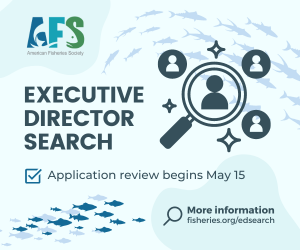Natalie Sopinka AFS Contributing Writer E-mail: [email protected] With more than 3,500 fish and fisheries professionals converging at the Oregon Convention Center, live-tweeting is a way to connect with fellow attendees as well as those who couldn’t make it to Portland. Whether an established or novice Twitter user, try capturing your 2015 Annual Meeting experience with Twitter. Not on Twitter? Download the AFS Conference Scheduler mobile app, and share your conference highlights with others using this communication and networking platform.  RECOMMENDATIONS FOR LIVE-TWEETING 1. Think in threes: A conference presentation tweet can be divided into three parts. First is the content of the talk you are tweeting. If you are directly quoting the speaker, use quotation marks. You may also wish to include links to the speaker/organization’s website or relevant publications. Second is the speaker’s name. To save character space, put only the speaker’s last name. If you know the speaker’s Twitter username/handle (e.g., @AFS2015), reference it instead of their last name. Third, be sure to include #AFS145 at the end of your tweets so your tweets don’t get lost in the Twitterverse! By searching for #AFS145 on Twitter, you can see what others are tweeting. 2. Reply to yourself: If you are tweeting multiple times during a talk, reply to your first tweet when writing subsequent tweets to create a chain of tweets. Your audience will be able to see all the tweets pertaining to a particular talk. Start a new chain for each talk you tweet. 3. Think about your audience: If you are tweeting to engage with Twitter users following #AFS145, keep the content broad and avoid jargon that those outside the specific study area may not know. Target your tweets to cover the natural history of the study species or the take-away message of the talk (i.e., content from the introduction and discussion; Shiffman 2012a). If you are tweeting to catalogue information you want to remember after the conference, you may tweet content that is more detailed. 4. Incorporate images: Tweets with images are more appealing visually but will reduce your 140-character limit. Photograph your early morning Spawning Run, field trip to the Klickitat River, and reunion with former colleagues. When using images that are not your own, always give credit to the artist of the image (Lewis 2014). If the artist has a Twitter account, you can tag them in the photo you choose to accompany your tweet without reducing the 140-character limit. If the artist does not use Twitter, mention their name in your main text. Taking a photograph of the speaker and/or their presentation slides can be distracting for both the speaker and the audience. Try to seek permission to photograph/tweet a presentation from the speaker prior to the talk. If this is not possible, you can write down your tweets and tweet them after introducing yourself to the speaker (Shiffman 2012b). 5. Take breaks: Tweeting is audio-visual-digital multi-tasking and can be time and energy consuming. You are listening to a speaker, condensing information into a dozen or so words, and trying not to forget the conference hashtag. Take breaks! Tweet a few talks per day. Tweet one day but not the next. Consider setting a tweet limit. It’s up to you! You can choose to tweet once per talk and summarize the study conclusions. You can tweet twice per talk and include background information in addition to conclusions. A tweet limit is flexible of course. If the speaker says something incredibly compelling that you want to share with Twitter followers, don’t feel constrained by your pre-determined tweet limit. 6. Correct mistakes: As David Shiffman, shark biologist and avid Twitter user states, “All science communicators and educators should strive to accurately relay information.” (Shiffman 2012). Still, conference talks are fast-paced, and rapidly texting thumbs or typing fingers may slip. Spelling errors are to be expected and generally are not condemned by Twitter users. If you have misheard the speaker and/or tweet content that is inaccurate, identify the erred content, and tweet a correction. Having a tweet limit in place and taking breaks (#5) reduces the sense of urgency in tweeting everything the speaker says, and thus, can reduce errors. 7. Continue the conversation: If fellow conference tweeters from other sessions are responding to your tweets, tweet back when you can and suggest meeting for coffee to chat without character limits. Conference tweeters can also arrange “tweetups” throughout the conference to connect in-person. If tweeters not attending the conference engage in your tweets, again, tweet back when you can. If Twitter users ask pertinent questions, engage the speaker into the conversation either during the question period or during a scheduled break. 8. Compile your conference notes: Similar to sketching your conference notes (Fisheries 40(7):338-339), tweeting is another alternative to traditional note-taking. At the end of the conference, #AFS145 tweets can be transformed into an online notebook using the program Storify (storify.com). You can include tweets from presentations you missed and the selfie you took with AFS President Donna Parrish. Easily share conference “notes” with colleagues by sending them the link to your “notebook.” 9. Twitter etiquette: Tweeting conference talks is an ever-evolving platform for information dissemination. Just as conferences are a professional forum to share advancements in knowledge and methodologies, and stimulate conversation among colleagues to build new collaborations, so Twitter should be too (Cordell 2013). If you have questions for the speaker, ask the speaker first, not the Twitterverse. Similarly, discuss your thoughts or comments on talk content with the speaker face-to-face so that they can respond and participate in the discussion. If speakers indicate that they do not wish to have their talks tweeted, respect their request. Also, be aware that staring down at your phone or typing on a laptop during a presentation may be interpreted as rude. REFERENCES Cordell, R. 2013. Mea Culpa: on conference tweeting, politeness, and community building. The Chronicle of Higher Education. Available: chronicle.com/blogs/profhacker/mea-culpa-on-conference- tweeting-politeness-and-community-building/45861. (June 2015). Lewis, N. 2014. Giving credit where credit is due. Nick Lewis Communications. Available: nicklewiscommunications.com/givingcredit- credits-due-twitter. (June 2015). Shiffman, D. 2012a. Twitter as a tool for conservation education and outreach: what scientific conferences can do to promote live-tweeting. Journal of Environmental Studies and Sciences 2(3):257-262. Shiffman, D. 2012b. How to live-tweet a conference: a guide for conference organizers and Twitter users. Southern Fried Science. Available: southernfriedscience.com/?p=12120. (June 2015).
RECOMMENDATIONS FOR LIVE-TWEETING 1. Think in threes: A conference presentation tweet can be divided into three parts. First is the content of the talk you are tweeting. If you are directly quoting the speaker, use quotation marks. You may also wish to include links to the speaker/organization’s website or relevant publications. Second is the speaker’s name. To save character space, put only the speaker’s last name. If you know the speaker’s Twitter username/handle (e.g., @AFS2015), reference it instead of their last name. Third, be sure to include #AFS145 at the end of your tweets so your tweets don’t get lost in the Twitterverse! By searching for #AFS145 on Twitter, you can see what others are tweeting. 2. Reply to yourself: If you are tweeting multiple times during a talk, reply to your first tweet when writing subsequent tweets to create a chain of tweets. Your audience will be able to see all the tweets pertaining to a particular talk. Start a new chain for each talk you tweet. 3. Think about your audience: If you are tweeting to engage with Twitter users following #AFS145, keep the content broad and avoid jargon that those outside the specific study area may not know. Target your tweets to cover the natural history of the study species or the take-away message of the talk (i.e., content from the introduction and discussion; Shiffman 2012a). If you are tweeting to catalogue information you want to remember after the conference, you may tweet content that is more detailed. 4. Incorporate images: Tweets with images are more appealing visually but will reduce your 140-character limit. Photograph your early morning Spawning Run, field trip to the Klickitat River, and reunion with former colleagues. When using images that are not your own, always give credit to the artist of the image (Lewis 2014). If the artist has a Twitter account, you can tag them in the photo you choose to accompany your tweet without reducing the 140-character limit. If the artist does not use Twitter, mention their name in your main text. Taking a photograph of the speaker and/or their presentation slides can be distracting for both the speaker and the audience. Try to seek permission to photograph/tweet a presentation from the speaker prior to the talk. If this is not possible, you can write down your tweets and tweet them after introducing yourself to the speaker (Shiffman 2012b). 5. Take breaks: Tweeting is audio-visual-digital multi-tasking and can be time and energy consuming. You are listening to a speaker, condensing information into a dozen or so words, and trying not to forget the conference hashtag. Take breaks! Tweet a few talks per day. Tweet one day but not the next. Consider setting a tweet limit. It’s up to you! You can choose to tweet once per talk and summarize the study conclusions. You can tweet twice per talk and include background information in addition to conclusions. A tweet limit is flexible of course. If the speaker says something incredibly compelling that you want to share with Twitter followers, don’t feel constrained by your pre-determined tweet limit. 6. Correct mistakes: As David Shiffman, shark biologist and avid Twitter user states, “All science communicators and educators should strive to accurately relay information.” (Shiffman 2012). Still, conference talks are fast-paced, and rapidly texting thumbs or typing fingers may slip. Spelling errors are to be expected and generally are not condemned by Twitter users. If you have misheard the speaker and/or tweet content that is inaccurate, identify the erred content, and tweet a correction. Having a tweet limit in place and taking breaks (#5) reduces the sense of urgency in tweeting everything the speaker says, and thus, can reduce errors. 7. Continue the conversation: If fellow conference tweeters from other sessions are responding to your tweets, tweet back when you can and suggest meeting for coffee to chat without character limits. Conference tweeters can also arrange “tweetups” throughout the conference to connect in-person. If tweeters not attending the conference engage in your tweets, again, tweet back when you can. If Twitter users ask pertinent questions, engage the speaker into the conversation either during the question period or during a scheduled break. 8. Compile your conference notes: Similar to sketching your conference notes (Fisheries 40(7):338-339), tweeting is another alternative to traditional note-taking. At the end of the conference, #AFS145 tweets can be transformed into an online notebook using the program Storify (storify.com). You can include tweets from presentations you missed and the selfie you took with AFS President Donna Parrish. Easily share conference “notes” with colleagues by sending them the link to your “notebook.” 9. Twitter etiquette: Tweeting conference talks is an ever-evolving platform for information dissemination. Just as conferences are a professional forum to share advancements in knowledge and methodologies, and stimulate conversation among colleagues to build new collaborations, so Twitter should be too (Cordell 2013). If you have questions for the speaker, ask the speaker first, not the Twitterverse. Similarly, discuss your thoughts or comments on talk content with the speaker face-to-face so that they can respond and participate in the discussion. If speakers indicate that they do not wish to have their talks tweeted, respect their request. Also, be aware that staring down at your phone or typing on a laptop during a presentation may be interpreted as rude. REFERENCES Cordell, R. 2013. Mea Culpa: on conference tweeting, politeness, and community building. The Chronicle of Higher Education. Available: chronicle.com/blogs/profhacker/mea-culpa-on-conference- tweeting-politeness-and-community-building/45861. (June 2015). Lewis, N. 2014. Giving credit where credit is due. Nick Lewis Communications. Available: nicklewiscommunications.com/givingcredit- credits-due-twitter. (June 2015). Shiffman, D. 2012a. Twitter as a tool for conservation education and outreach: what scientific conferences can do to promote live-tweeting. Journal of Environmental Studies and Sciences 2(3):257-262. Shiffman, D. 2012b. How to live-tweet a conference: a guide for conference organizers and Twitter users. Southern Fried Science. Available: southernfriedscience.com/?p=12120. (June 2015).






